De (in Vlaanderen) beroemde portretschilder Pieter Pourbus komt uit Gouda. U heeft nooit van hem gehoord. Straks wel. Museum Gouda brengt van 17 februari 2018 tot 17 juni 2018 de eerste Pieter Pourbus-tentoonstelling in Nederland.
Ter voorbereiding hierop moet je eerst naar het Groeningemuseum in Brugge. In de ongegeneerd bourgondische Werelderfgoedstad loopt tot 21 januari de tentoonstelling Pieter Pourbus en de Vergeten Meesters.
Restaurant Pieter Pourbus
Pieter Pourbus (Gouda, 1523 – Brugge, 1584) was een man van faam. Hij groeide op in Gouda en drukte in Brugge zijn stempel op de schilderkunst. Pourbus was met Pieter Paul Rubens een van de allerbeste portrettisten van Vlaanderen, met grote invloed op zijn tijdgenoten. Gouda kent de Pieter Pourbusstraat. In Brugge is uiteraard een Pieter Pourbusstraat en ook een Restaurant Pieter Pourbus (‘Genieten in Hartje Brugge.’). Dan houdt het wel op. Het is ook weer niet zo dat de Bruggenaren Pieter Pourbus in het hart hebben gesloten.
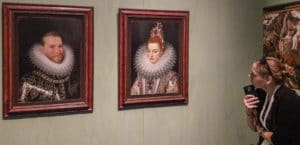
Pieter Pourbus, stamhouder van het schildersgeslacht der Pourbussen, wordt gezien als de vertolker van de zwanenzang van de Brugse School: ‘de laatste der Vlaamse Primitieven’.
Het Athene van het Noorden
Brugge, ooit het Athene van het Noorden, raakte in de 15de eeuw in rampspoed en continu verval, alsof een banvloek over de Vlaamse stad was uitgesproken. De recessie sloeg toe. De waterweg naar de Noordzee verzandde zodat de haven waardeloos werd. Bovendien kwamen de Brugse schepenen op het lumineuze idee om in 1488 de Habsburgse Keizer Maximiliaan I gevangen te zetten en enige personen uit zijn aanhang te executeren.
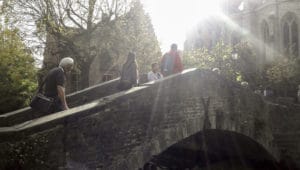
Niet zo handig. Het is of je Lionel Messi tijdens de Champions League in de kerker gooit en hoopt op betere tijden. Vier maanden bleef de keizer gevangen. Op voorwaarden werd hij vrijgelaten, waarop zijn vader Frederik III direct met een leger naar Brugge marcheerde.
Slim trouwen
De 16de werd voor Brugge een eeuw van zware armoede. De rijke elite dunde uit en steeds minder jonge kunstenaars vestigen zich in de stad. De meeste kunstopdrachten gingen naar Antwerpen en Gent. Rijke opdrachtgevers in Brugge waren net zo talrijk als miljardairs in Emmeloord.
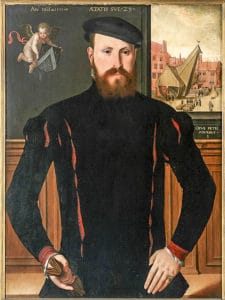
Pieter Pourbus was de artistieke uitzondering. Hij was een meesterschilder. Wat hem mede vooruit hielp was dat hij slim trouwde. Een strategie die hij mogelijk van de Habsburgers – die daarmee hun rijk voortdurend uitbreidden – heeft afgekeken.
Opdrachten binnenslepen
In 1543 huwt Pourbus de dochter van de gerenommeerde kunstenaar Lancelot Blondeel. Onder het ervaren oog van deze Brugse meester ontwikkelt Pourbus zich tot groot talent en weet hij veel belangrijke opdrachten binnen te slepen. Van de grafkapel van Margaretha van Oostenrijk, het ‘Laatste Oordeel’ en de ‘Annunciatie’ tot portretten van voorname Brugse families.
https://www.youtube.com/watch?v=vu83Gn_kfpk
Pieter Pourbus de cartograaf
Het opmerkelijke is dat portretschilder Pourbus in Brugge vooral als cartograaf het meeste aanzien verwierf. Hij kreeg de opdracht om ‘wateringswerken’ en fortificaties te plannen, in verband met de problematische waterhuishouding in Brugge en omgeving. Pourbus schilderde landkaarten. In 1562 maakte hij een enorme kaart van Brugge, die ook op de expositie in het Groeningemuseum is te bezichtigen.
Frans Pourbus naar Antwerpen
Pieter I Claeissens en zijn zonen Gillis, Pieter II en Antonius zijn de Vergeten Meesters van de tentoonstelling. Recent onderzoek reconstrueerde hun eeuwenlang onbekende oeuvre. In Brugge maak je kennis met hun uitgebreide collectie schilderijen. Frans I, de zoon van Pieter Pourbus, slaat de brug naar Antwerpen. Hij vertrekt op jeugdige leeftijd naar de kunstmetropool. Zoon Frans de Tweede gaat bij grootvader Pieter Pourbus in de leer voor de portretkunst.
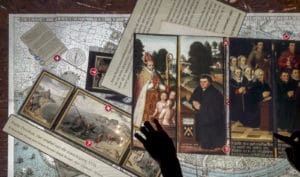
Hij maakt uiteindelijk de staatsieportretten voor de aartshertog Albrecht van Oostenrijk en de (latere) landvoogdes Isabella van Spanje, dochter van koning Filips II. Aldus wordt de ‘vervallen’ Brugse schilderkunst de basis voor zijn internationale roem.
‘Probleemoplosser’ Alva
Maar ook Antwerpen ontkomt in de 16de eeuw niet aan het onheil. ‘Probleemoplosser’ Alva kwam een jaar na de Beeldenstorm (1566) naar de Nederlanden om orde op zaken te stellen. Hiermee kwam een einde aan de voorspoed van de zuidelijke Nederlanden. Voor Vlaanderen pakte de strijd tussen Spanje en de Nederlanden rampzalig uit. De protestantse inwoners kregen vier jaar de tijd om terug te keren tot de katholieke kerk of te vertrekken. Het inwoneraantal van Antwerpen (voorheen 85.000) slonk tot 40.000. Veel protestantse ondernemers vluchtten naar steden als Leiden, Haarlem en Amsterdam. Er kwam een einde aan Antwerpens Gouden Eeuw als haven-, handel- en kunststad. De Nederlandse economie groeide explosief, vooral door de stroom van vakkundige zuidelijke immigranten.
Toerisme Vlaanderen slaat terug
Pieter Pourbus keert op 20 februari 2018 terug in Nederland, Gouda. Dat wil zeggen: zijn schilderijen. En Toerisme Vlaanderen slaat de komende twee jaar fors terug. Van 2018 tot 2020 organiseert VisitFlanders een reeks evenementen om bezoekers uit de hele wereld naar Vlaanderen te lokken om kennis te maken met de Vlaamse Meesters.
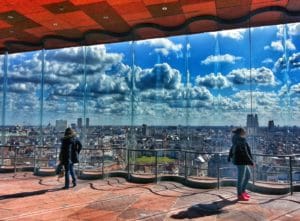
In 2018 staat ‘Antwerpen Barokstad’ in het teken van Rubens. Kers op de taart is de heropening van het Koninklijk Museum voor Schone Kunsten Antwerpen in 2019.
In hetzelfde jaar wordt in heel Vlaanderen de 450ste verjaardag van Bruegel herdacht. In 2020 keert het minutieus gerestaureerde Lam Gods van Jan en Hubert van Eyck terug naar de Sint-Baafskathedraal in Gent.
Pieter Pourbus en de vergeten meesters: tot en met 21/01/2018, Groeningemuseum, Brugge. Zie visitbruges.be/pieterpourbus
Groeningemuseum, Brugge. Zie visitbruges.be/pieterpourbus
Pieter Pourbus, meester-schilder uit Gouda: van 20 februari tot 17 juni 2018 in Museum Gouda. Zie museumgouda.nl/agenda/2017-06-30/pieter-pourbus-meester-schilder-uit-gouda/
Beleef de Vlaamse Meesters, 218-2020: zie visitflanders.com
